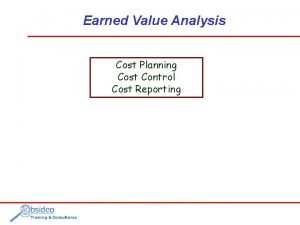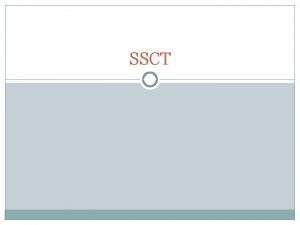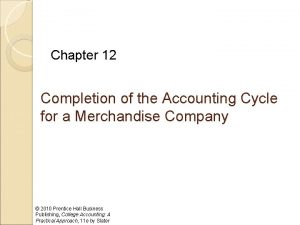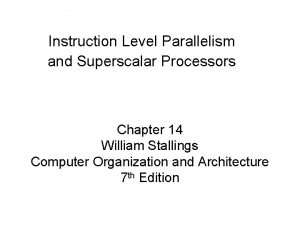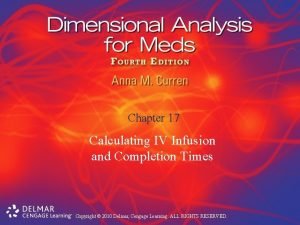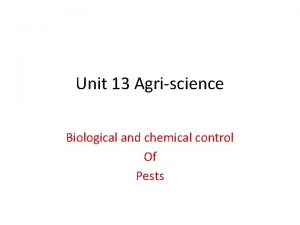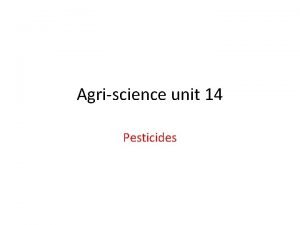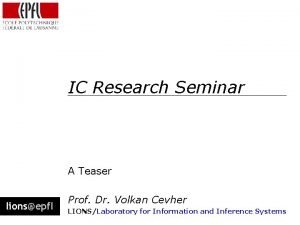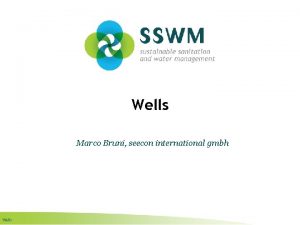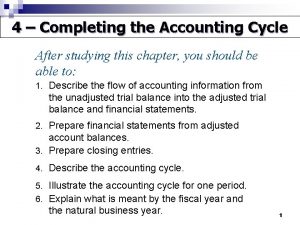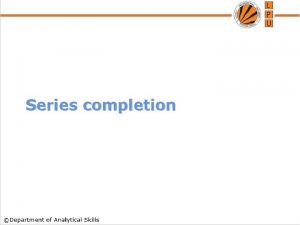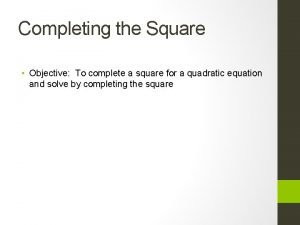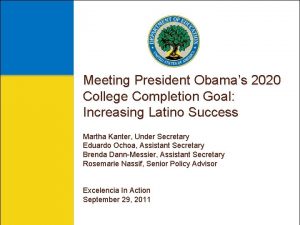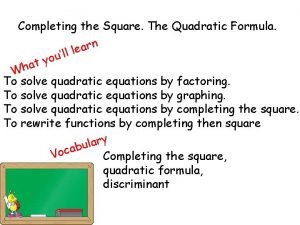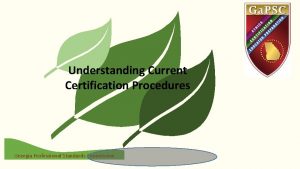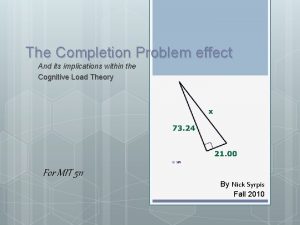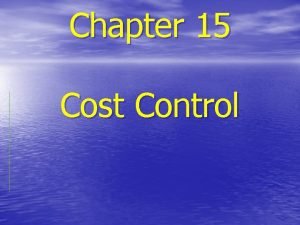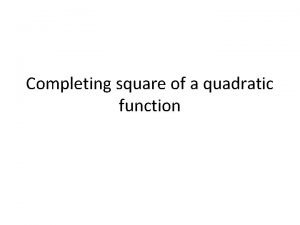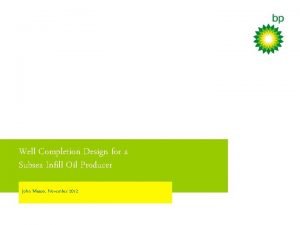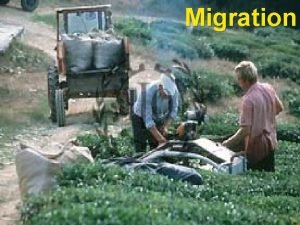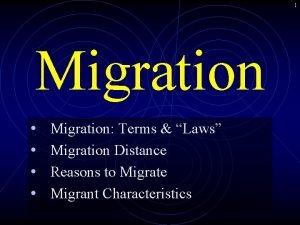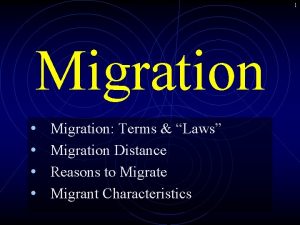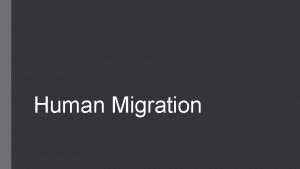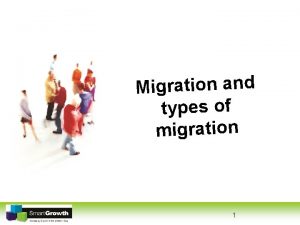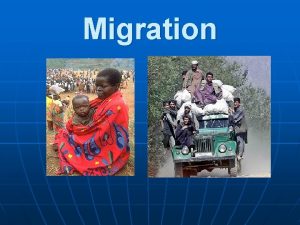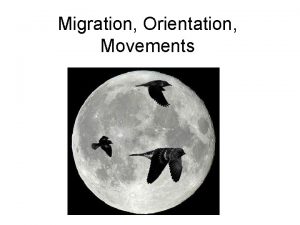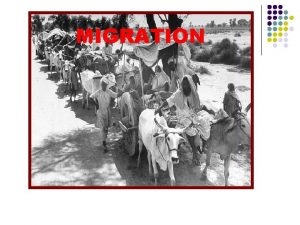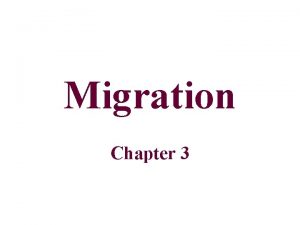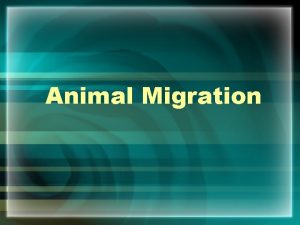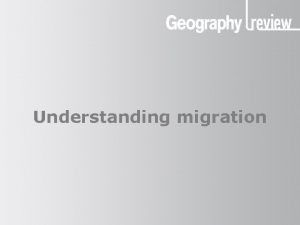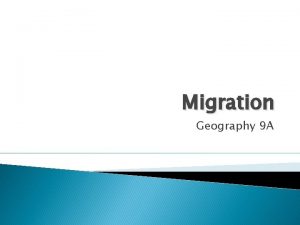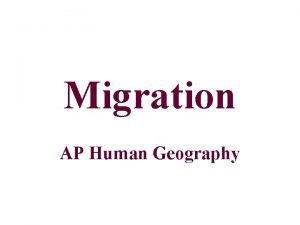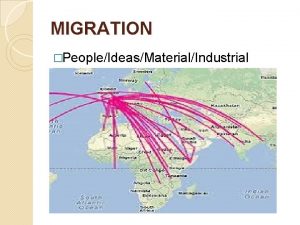Migration Upon the completion of this module the














































- Slides: 46

Migration

Upon the completion of this module, the student will be able to : § Define migration and its different forms § Define pull and push factors for migration. § Describe the consequences of migration § Define urbanization

What is Migration? Migration: The act of moving to a new place outside the community of origin; with the purpose of establishing a new permanent or semi-permanent residence.

2. International Migration: Moves between countries § Immigration : move into a new country § Immigrant: An international migrant who enters the area from a place outside the country.

Emigration: move out of home country. § Emigrant: An international migrant departing to another country by crossing the international boundary.

3. Internal migration: Moves within a country § In-Migration: movement into a new geographically/ administratively defined area within the same country. § In-Migrant : A person who moves into a new area within the same country��

Types of Migration • Voluntary migration – The migrant makes the decision to move. • Involuntary – Forced migration in which the mover has no role in the decisionmaking process.

– Refugees. – Military conscription. – Children of migrants. – Situations of divorce or separation.

Meanings • Lina decides to leave her home town for good and move to a new area. • Ahmed moves from Emirates to Saudi Arabia. • Rana and her family have to leave Iraq because of the war.

• Huda is happy in Riyadh but decides to move to Jeddah for a new job and better standard of living. • Ali travels from Kharg to Riyad each day to go to work. • Nadia moves to Jeddah every summer to work in the tourist area.

1. International migration • Ahmed moves from Emirates to Saudi Arabia. 2. Forced migration • Rana and her family have to leave Iraq because of the war 3. Seasonal regional migration • Nadia moves to Jeddah every summer to work in the tourist area.

4 - Voluntary migration Huda is happy in Riyadh but decides to move to Jeddah for a new job and better standard of living. 5. Permanent migration Lina decides to leave her home town for good and move to a new area. 6. Daily migration Ali travels from Kharg to Riyad each day to go to work.

Sources of migration data ü Population censuses ü Population registers ü Sample surveys ü International migration statistics records ü Other sources

• Why do people move? • All migration is a combination of push and pull factors.

Characteristics of Migrants • Historically, males were more likely than females to migrant internationally Ø Because men worked more than women and left to find job opportunities Ø Since the 1990 s, female migrants are on the rise Ø Most long distance migrants are young adults seeking work –not children or elderly


Push Factors: Things that force/“push” people out of a place. • War/crime and violence • Lack of basic infrastructure (light, roads, …. ) • Limited number of jobs • Overpopulation

• Few health facilities • poor educational opportunities • Political persecution • Environmental problems • Lack of technologies


Pull Factors factors that encourage a person to come to a new place • Better standards of living • Job opportunities • Religious Freedom • Availability medical care

• • Weather Conditions Education Opportunity Better climate Political stability

Effects of international migration For the ‘gaining’ country • It gains a bigger often cheaper labour force. • It needs to provide more services for extra people. • Immigrants sometimes set up shanty towns in the cities • It receives new ideas and cultures.

Effects of international migration For the ‘losing’ country • It loses many 20 -35 year olds and their children, so the population rises less quickly. • It can cause family break-ups as it is often just the male who migrates. • People who move away send money back to their families.

Indicators for Studying Migration Crude In-Migration Rate: Number of in-migrants per 1, 000 population = (I/P) * 1000 Crude Out-Migration Rate Number of out-migrants per 1, 000 population = (O/P) * 1000

Crude Net Migration Rate Difference between the number of inmigrants and the number of outmigrants per 1, 000 population = (I – 0)/P * 1000

Calculate the crude net migration rate for Zimbabwe in 1987, based on the following data Zimbabwe, 1987 Long-term immigrants: 3 925 Long-term emigrants : 5 330 Total population : 8 640 000

What is urbanization n It is the growth of cities, brought about by a population shift from rural areas and small communities to large ones. n Urbanization is the process by which there is an increase in the proportion of people living in urban area.

Why move to cities • Escape constraints of village • Education Opportunity • Job opportunities • Better social services: Ø Availability medical care Ø Government offices • Variety of entertainment

Drawbacks of urbanization • Huge demand on land, water, transport, housing and employment. • Problem of waste and sanitation. • Crime and violence. • Homelessness. • Unemployment

Urban population: Persons living in cities or towns of 2, 500 or more residents. Urbanized area: One or more places and the adjacent densely populated surrounding area that together have a minimum population of 50, 000. Mega-cities: Cities with 10 million residents or more.


Strategies for Reducing Urban Growth 1. Promoting agricultural development in rural areas. 2. Providing incentives to industries and businesses to relocate from urban to rural areas.

3. Providing incentives to encourage new businesses in rural areas. 4. Developing the infrastructure of rural areas, including transportation systems, clean water supplies, sanitary waste disposal systems, and social services.

Environment of Cities • Transportation problems (commute to work) • Air – Smoke & dust (particulates) – Hydrocarbons, nitrous oxides, ozone • Water – Usually must be piped in from distance. – Pollution from industrial waste, – Human waste (sewage).





• Solid waste, garbage, litter. • Spread of infectious diseases – Common cold, influenza, measles – Cholera, typhoid fever, plague – Malaria, yellow fever, dengue, West Nile virus

Migration-consequences • Overcrowding • Mushrooming of slums • Unemployment • Poverty • Physical & mental stress • Change of Family structure-Nuclear families

Overcrowding and related health issues • Rapid growth of urban centers has led to substandard housing on marginal land overcrowding • Outbreaks of diseases transmitted through respiratory and faeco-oral route due to increased population density

• It exacerbates health risks related to insufficient and poor water supply and poor sanitation systems. • Lack of privacy leading to depression, anxiety, stress etc

Air pollution and its consequences • Due to increase in the numbers of motorized vehicles and industries in the cities of the developing world • Air pollution can affect our health in many ways with both short-term and long-term effects

• Short-term air pollution can aggravate medical conditions like asthma and emphysema. • Long-term health effects can include chronic respiratory disease, lung cancer, heart disease, and even damage to other vital organs

Water and sanitation problems • Nearly 1. 1 billion people worldwide do not have access to clean drinking water and over 400 million people, lack simple improved latrine. • This can lead to increased episodes of diarrhea and other communicable diseases.

• The rising trends of non-communicable diseases are a consequence of the demographic and dietary transition. • Decreases in activity combined with access to processed food high in calories and low in nutrition have played a key role
 C device module module 1
C device module module 1 Thematic apperception
Thematic apperception Estimate at completion
Estimate at completion In order issue in order completion example
In order issue in order completion example Lesson 7 sentence completion
Lesson 7 sentence completion Ssct test
Ssct test Completion of the accounting cycle
Completion of the accounting cycle Superscalar architecture diagram
Superscalar architecture diagram Adequate planning leads to the correct completion of work
Adequate planning leads to the correct completion of work Sentence completion activity
Sentence completion activity Calculating infusion time and completion time
Calculating infusion time and completion time Agriscience unit 13 completion answers
Agriscience unit 13 completion answers Agriscience unit 14 completion answers
Agriscience unit 14 completion answers Tasos kyrillidis
Tasos kyrillidis Spelling of completion
Spelling of completion 4 types of wells
4 types of wells Doctoral initiative on minority attrition and completion
Doctoral initiative on minority attrition and completion What is series completion
What is series completion Www.mhhe.com/yacht 2019
Www.mhhe.com/yacht 2019 Algoritma adalah urutan langkah-langkah logis
Algoritma adalah urutan langkah-langkah logis Completing the accounting cycle
Completing the accounting cycle The selection structure is the completion of
The selection structure is the completion of Ba_ba_bac_acb_cbac
Ba_ba_bac_acb_cbac Discourse completion task
Discourse completion task Sentence completion activity
Sentence completion activity Complete the square examples
Complete the square examples Us 2020 college completion goal
Us 2020 college completion goal Completion of the square
Completion of the square Tpms program completion form
Tpms program completion form Accounting closing entries worksheet
Accounting closing entries worksheet Semantic scene completion from a single depth image
Semantic scene completion from a single depth image Coc certificate of completion
Coc certificate of completion Exact matrix completion via convex optimization
Exact matrix completion via convex optimization Completion point linguistics
Completion point linguistics Accounting chapter 4
Accounting chapter 4 Seguro completion bond
Seguro completion bond Completion problem effect
Completion problem effect Percentage of completion method
Percentage of completion method Estimate at completion (eac) is a periodic evaluation of:
Estimate at completion (eac) is a periodic evaluation of: Assignment completion strategy
Assignment completion strategy Rrc wellbore query
Rrc wellbore query Task completion email sample
Task completion email sample Complete the sqaure formula
Complete the sqaure formula Subsea well completion
Subsea well completion Intensive speaking tasks
Intensive speaking tasks Bài hát chúa yêu trần thế alleluia
Bài hát chúa yêu trần thế alleluia Khi nào hổ mẹ dạy hổ con săn mồi
Khi nào hổ mẹ dạy hổ con săn mồi


